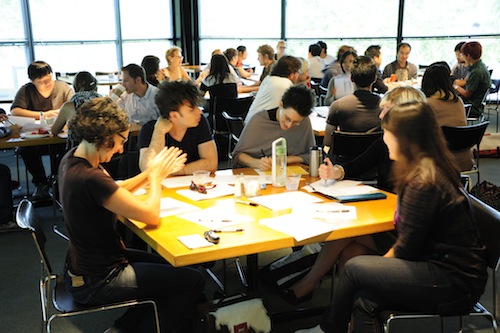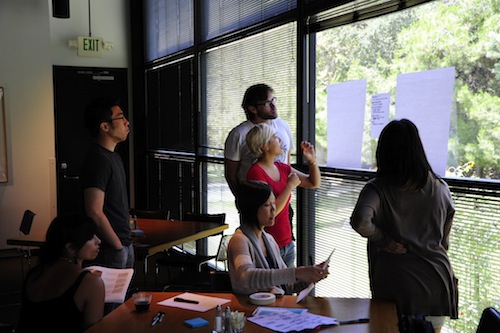“Go ahead and join a group.” This was David Sherwin’s opening directive to the students and faculty members spilling into Art Center’s faculty dining room for the Designmatters-sponsored Collective Action Toolkit workshop. Sherwin, interaction design director and researcher at frog design in San Francisco, was not merely suggesting attendees sidle up to strangers. It was a non-negotiable requirement, which I discovered when I suggested I would not join a group because I only present to observe and report. “This is all about collaboration, so why don’t you find a group and participate?”
Roger that. Next thing I knew, I had wedged myself into a table full of students seated near the back of the room. We then embarked on our first assignment — writing our names and special talents on separate pieces of paper, which we’d then merge into one document listing our group’s core competencies. This exercise represents the Collective Action Toolkit’s first step in assessing the resources available to each collaborative cohort. In our case, we possessed an unsurprising abundance of design, drawing and drafting skills along with singing, writing and storytelling. Though we had no idea what task we would be asked to perform; it was hard, at that point, to see how this hodgepodge of talents would meld into a whole that was stronger than the sum of its parts.
We needn’t have worried. Sherwin and his colleagues at frog specifically designed the Collective Action Toolkit to work for any random grouping of people united only by a desire to create something – anything – that once seemed daunting or even unimaginable. The Toolkit was originally conceived to assist The Girl Effect movement, created by the Nike Foundation to equip adolescent girls with the resources to participate in stemming the tide of poverty for themselves and others like them around the world. The idea being: If young girls empower themselves to become financially, emotionally and physically self-sufficient by banding together and devising the means to support themselves and remain HIV-negative, they will naturally lead by example and create a positive cycle for future generations.
In other words, the Collective Action Toolkit, was designed to fuel the ultimate girl power movement by offering step-by-step instructions, activities and exercises to foster creativity, ingenuity, problem solving and, perhaps most importantly, self-esteem. “The Toolkit trains girls to be explorers,” said Sherwin, who describes the project as ‘opportunistic ethnography.’ “Through all this brainstorming they experience their ideas being taken seriously. One of the most gratifying moments was when one of the girls from Kibera, a vast slum in Kenya, said, ‘This was the first time we realized that ideas were in our heads, not just in other people or in books.’”
By empowering at-risk girls to reach beyond their own perceived limitations, the Toolkit offers proof that power in numbers can be harnessed to become a precision-crafted instrument for creating change in the world. Now Sherwin and his colleagues at frog have expanded the project’s reach by making the Toolkit available as an open source vehicle (available for download here) to teach inquiry, leadership and problem solving in any environment where those skills might be of use.
The Toolkit’s applications to the design field (particularly any project aimed at creating social impact) are vast. And its simple slogan – “groups make change” – played out quite literally among the groups assembled at Art Center. Charged with coming up with a list of potential projects based on our needs, our group settled on a plan to integrate Art Center’s Hillside and South campuses. We then spent about an hour in a Toolkit-designed brainstorm dubbed the “jam session,” through which we identified actions and elements that might contribute to greater unity between Art Center’s two hubs. Some of these ideas existed within the realm of possibility – more frequent shuttles, motorized bikes, locate essential functions and classes on both campuses forcing students to move fluidly between both locations. Other ideas were more far-fetched, but no less informative about the groups needs and wants – travelling classroom bus, student-run radio station, studio and nap spaces for undergrads in the air tunnel.
Even if we didn’t come up with an actionable solution to the disconnect students feel between the school’s two campuses, the process yielded valuable insights into our common needs for a sense of an integrated community that makes the most of its resources. Perhaps the bigger revelation was that each member of our group took a leadership role at various points in the process and presided over what became a passionate and lively merging of the minds. And, who knows, maybe that traveling party bus/classroom may hold he key to bridging the gap between Art Center, North and South, at some point in the not-so-distant future.
In the spirit of collaboration, we encourage you to continue the conversation about how to improve upon the Art Center experience in the comments section below.











